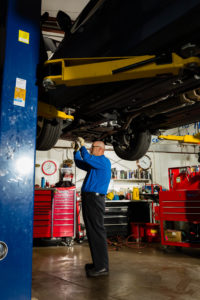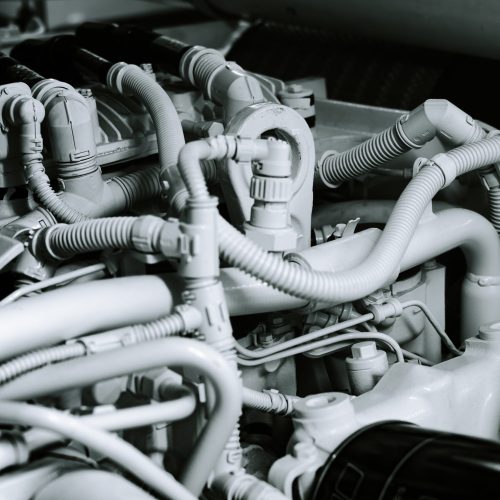The Value of an “Accurate” Diagnosis
Because we often get customers questioning why we charge for diagnostic procedures to determine the cause of 
Years ago, cars were much more basic and straightforward, and problems were not as complicated to find and solve. Even now, some problems are easy to figure out and fix. Brake pulsations are usually a warped rotor or squeaky belts generally require an adjustment or replacement. Diagnostics are often not required in these situations. However, with most of the today’s vehicle systems being controlled by complex computer systems and sensors, figuring out problems takes time, experience and expertise, and technical diagnostic tools.
For example, if your Check Engine Light comes on, there are numerous diagnostic trouble codes that the Check Engine Light could refer to. Many think that when we plug a Code Reader into your car, the code gives us the answer to your car’s problem. However, that is only a starting point. Those codes are simply “breadcrumbs” that point us in the right direction. Our shop has Code Readers at our front desk, and we will gladly pull a “code” for our customers free of charge. But then the real work begins in finding out the specific problem.
Think of when you have gone to your primary physician with a complaint of pain. The doctor asks questions about where the pain lies, when it occurs, he/she will palpate the area of pain to feel for swelling or a mass, he/she then tries to reproduce the pain with specific movement patterns, and orders imaging tests or bloodwork that will give more information. That is all diagnostic testing. Then it is up to the experienced and skilled physician to pull all the information from the tests together, interpret the origination of the problem, and develop the solution and treatment options. This takes time, expertise, and thoughtful consideration, as there is generally more than one option in treating a problem.
Similarly, there may be several problems that can cause one code to pop up or a Check Engine Light to turn on. As “Accurate” technicians, it is then our responsibility to determine the exact cause of the problem, leading to the proper solution and repair.
For example, it is common for a code to read “oxygen sensor”. All that means is that the air/fuel mix is not right (fuel cannot combust efficiently without the correct air/fuel ratio). If we simply replace an oxygen sensor, which is the simple fix, it is likely that would not fix the problem. Then, who looks bad? In order to be Accurate, we need to test further and get further information.
Testing the fuel system includes testing fuel pressure and flow, electronic testing of the air metering system (mass air flow sensor), and checking cam and crank sensors or coils that maybe causing random misfires. It takes an experienced technician who knows where to look and when to look (hot vs. cold engine, at a specific RPM, etc). Some problems only show up intermittently, which makes finding the problem even more interesting. Leaking intake gaskets may “fix” themselves (temporarily) by the time you drive to our shop because the engine heats up. The heat of the engine makes the parts expand, thereby temporarily closing the leak that is causing the computer codes to be tripped in the first place. An experienced technician will know that they need to let the engine cool before starting certain diagnostics, or he may need to check how the engine is performs at varying temperatures.
First, our technician needs as much information that you, as the owner and driver, can give us. Such as:
- When does the problem occur? Hot or cold engine? Under load or coasting?
- When do you hear the noise that you are concerned about? (Going over a bump, around a corner, coming to a stop, etc.)
- Is the noise or problem constant or inconsistent? When does it occur?
- When does the “symptom” (noise or behavior) become worse or totally go away?
- What else have you noticed? Did it start after a recent refueling?
- Have you tried to fix the problem yourself? Or has another shop tried to fix the vehicle?
In addition, we often have one of our Service Advisers or Technicians ride with you, so that they actually experience and hear what the problem is that you are noticing. We want to fix the problem that you have brought your car in for.
Our technician will then utilize a Scan Tool, which will provide more specific information than a Code Reader. In particular, it will provide the technician with manufacturer (Ford, Toyota, BMW, Honda, etc.) specific information for the vehicle, and values that are recorded at the time of the fault (RPM, speed, temperature, etc.). Scan tools (which can run $12-18,000 and require yearly updates at $1500/year) provide much more specific information that help our technicians know where to start looking.
Then the technician must physically find the leak or faulty part. They must be able to reproduce the symptoms of the problem (noise, difficulty starting, misfires, etc.) Be aware that even if a technician has many years of experience, if he has not continued his education and followed the changes in computer technology, he will not be able to solve many of the problems in today’s cars. In our shops, specific diagnostic work is only given to those technicians who are trained and experienced at diagnosing the type of problem your vehicle is experiencing.
Following the diagnostic procedure, the Technician will then make their recommendations, and your Service Adviser will contact the customer, translating the technician’s information into easy-to-understand language, as well as give you estimates on parts and labor to complete the repair. The ultimate decision to move forward in repairs is then up to you, the customer – we do nothing without customer approval.
Take this real-life example of a customer who was sure he knew what the problem was with his car. He was having trouble with his car starting, so he brought in an ignition coil module assembly for us to install. We recommended diagnostic work to confirm his “diagnosis”, but he chose to proceed without our diagnostic expertise. We had to warn him that if this did not fix the problem, we could not be responsible for that under warranty, because we could not guarantee that this was the problem. (we don’t like being in this position either). That particular part did not fix the problem. When we spent the time to diagnose the issue, it was found to be a crankshaft position sensor fault. Diagnosing and replacing the correct part in the first place would have saved this customer money in the long run. Please remember that that is our true goal – to save our customers money. We look better and customers are happier!
Paying for competent auto diagnostic services is worth your time and money. Fixing a problem correctly the first time saves our customers time, money and frustration. That is our goal at Honest Accurate Auto Service. Let us help you solve your vehicle problems!




